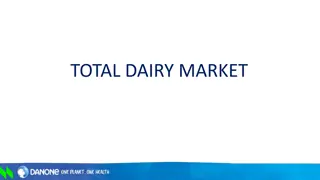USDA Non-Dairy Milk Substitutes September 2015
Explore the USDA regulations and guidelines for non-dairy milk substitutes, focusing on cow's milk and soy milk. Learn about food allergies versus intolerances and the importance of approved substitutions. Understand the serving regulations for milk in CACFP meals and the accommodations required for individuals with dietary needs.
Download Presentation

Please find below an Image/Link to download the presentation.
The content on the website is provided AS IS for your information and personal use only. It may not be sold, licensed, or shared on other websites without obtaining consent from the author.If you encounter any issues during the download, it is possible that the publisher has removed the file from their server.
You are allowed to download the files provided on this website for personal or commercial use, subject to the condition that they are used lawfully. All files are the property of their respective owners.
The content on the website is provided AS IS for your information and personal use only. It may not be sold, licensed, or shared on other websites without obtaining consent from the author.
E N D
Presentation Transcript
USDA Non-Dairy Milk Substitutes September 2015
Agenda Introduce Cow s Milk and Soy Milk USDA CACFP regulation for serving milk School regulation Food allergy vs. intolerance; brief overview USDA regulation for making substitutions What is an approved substitute Best practices and Questions 2
Cows Milk Cow s milk First the cream is removed leaving all liquid fat free (little to no fat). Different amounts cream (fat) is added back in Depending on 1%, 2%, ..etc All milk served in program must be pasteurized Various time and temperature exposure to heat and kill bacteria, can produce a shelf stable product if time and temp is right. Most milk is homogenized, and often fortified (vit D) as heat treatment destroys some vitamins and minerals. 3
Soy Milk Soy Milk Soy Beans are soaked Ground with water Heated and than filtered 4
USDA Regulation for Milk CACFP meal pattern regulation states fluid milk as a beverage must be served as part of breakfast, lunch and supper, and is an optional component for snack (am/pm). Snack could also include 100% fruit juice or water (as long as two other meal componets are served). Regardless of meal service the portion size remains the same depending on the child s age. 5
Food allergy vs. intolerance Allergy: A true food allergy causes an immune system reaction that affects numerous organs in the body. A food allergy may be considered a disability under federal laws, such as Section 504 of the Rehabilitation Act of 1973 and the Americans with Disabilities Act (ADA). Law requires institutions and organizations to make reasonable accommodations. Food intolerance symptoms are generally less serious and often limited to digestive problems. "Food Allergy." Vs. Food Intolerance: What's the Difference? Web. http://www.mayoclinic.org/diseases-conditions/food-allergy/expert- answers/food-allergy/faq-20058538. 25 Aug. 2015. Advocacy - Disability - Food Allergy Research & Education." Advocacy - Disability - Food Allergy Research & Education. Web. http://www.foodallergy.org/advocacy/disability. 25 Aug. 2015. 7
Regulations Covering this Population CACFP: 7 CFR 226.20 Institutions may make menu substitutions for children or adults with a medical or other special dietary need, when indicated on a note signed by a licensed physician or recognized medical authority. - ADA requires that reasonable accommodations must be made for food allergies documented by a medical authority. The Healthy Hunger-Free Kids Act of 2010: non-dairy milk substitutions may be made for non-disabled children and adults in the Child and Adult Care food Program (CACFP), according to section 221 part 3 of the law. 8
Approved Non-Dairy Substitutes Calcium ... 276 mg Or ( 27.6% DV) Protein .. 8g Vitamin A ... 500 IU Or ( 10% DV) Vitamin D ... 100 IU Or ( 25% DV) Magnesium 24 mg Or ( 6% DV) Phosphorus . 222 mg Or ( 22.2% DV) Potassium ... 349 mg Or ( 9.9% DV) Riboflavin .... 0.44 mg Or ( 25.8% DV) Vitamin B12 ... 1.1 mcg Or ( 18.3% DV) USDA nutrient specifications per 8oz. *Important: if the Nutrition Facts label does not provide all required nutrient information, the organization must contact the manufacturer to obtain additional nutrient information to ensure compliance with the above specifications. 9
Resources Flyer with more information. Excel calculator to verify nutrients. 10
Questions Delaware Department of Education Nutrition Programs 35 Commerce Way Dover DE, 19904 302.857.3356 (office) 302.739.6397 (fax) Jason.Brown@doe.k12.de.us 11























